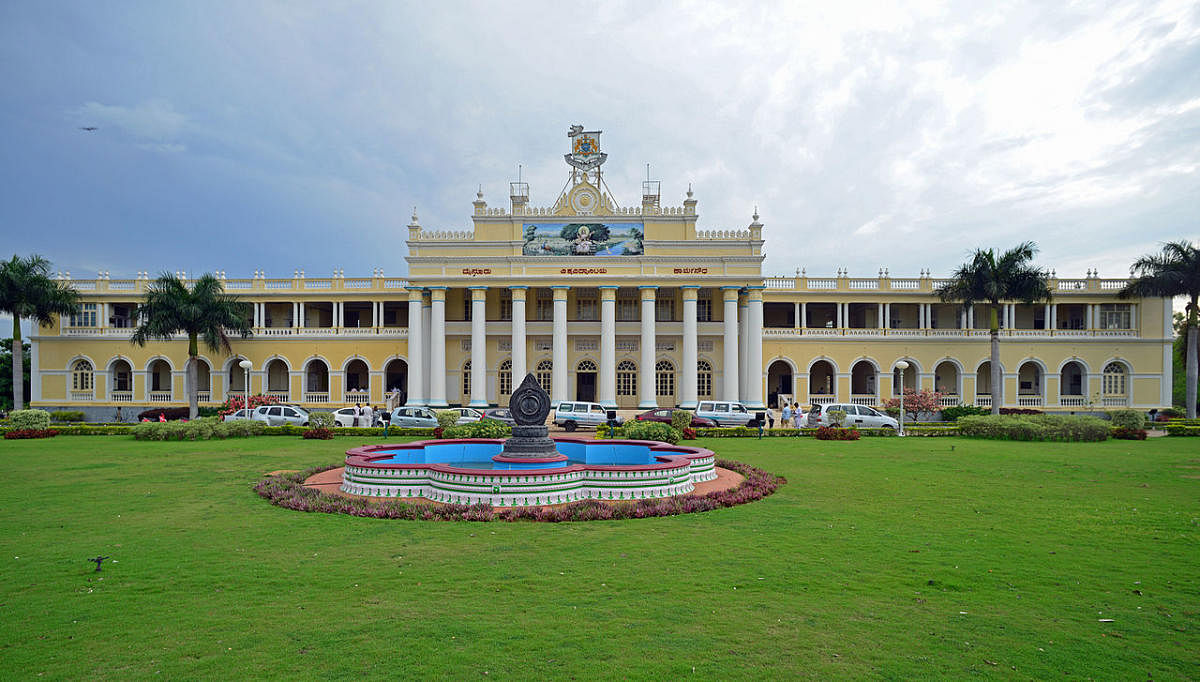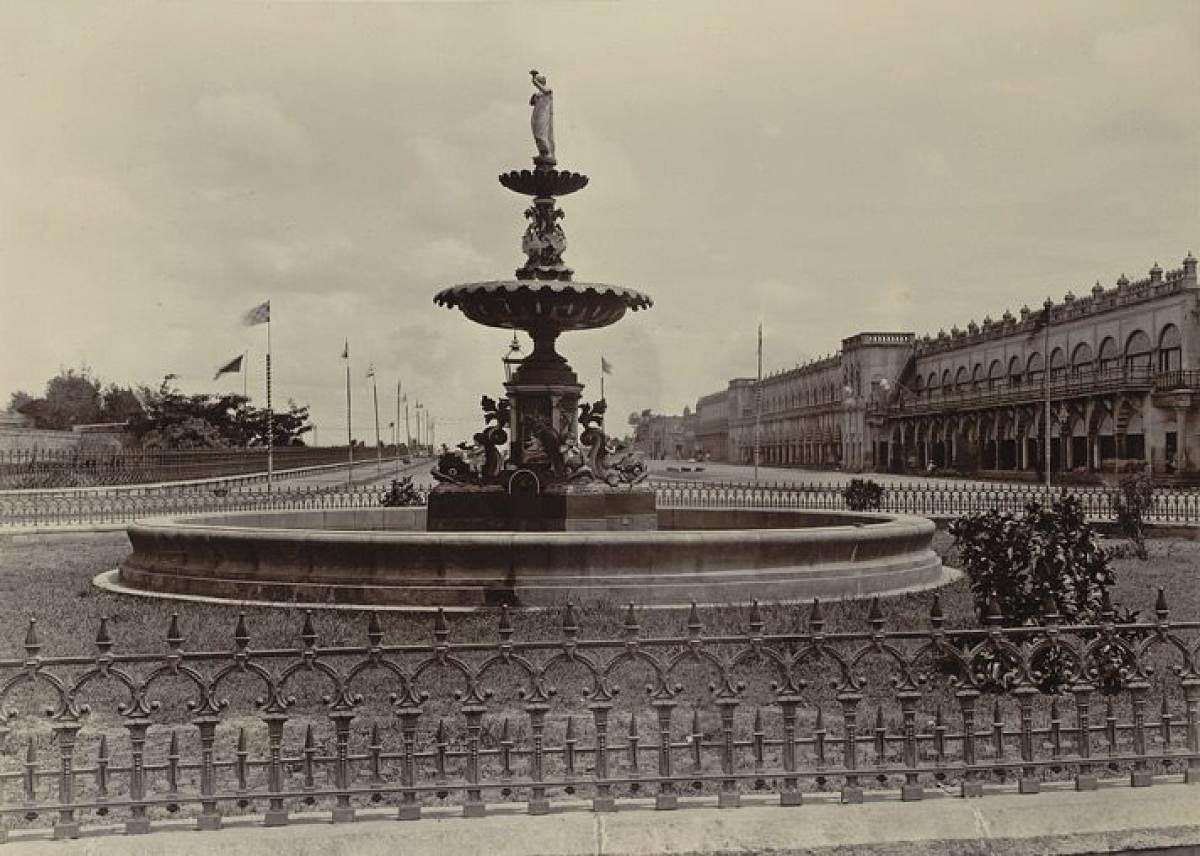

Colonial landmarks of Mysuru can be traced from the time of shifting of the capital from Srirangapatna to the days of the mid-20th century.
The earliest-known landmark is the Wellington Lodge and the latest one on the list is Irwin Road.
Here are some of the landmarks that came up during the period of Krishnaraja Wadiyar IV:
Elgin Fountain Circle
Lord Elgin, Viceroy and Governor-General of India from 1894 to 1899, was shocked to hear the death of Chamaraja Wadiyar X on December 28, 1894.
During his two-month stay in Bombay in 1893, the maharaja had met Elgin, when the latter was on his way to Calcutta to assume the viceroyalty from Lord Lansdowne. Again, a week prior to his demise, the maharaja had met Elgin during his fateful visit to Calcutta in 1894.
To console the bereaved royal family, Lord Elgin visited Mysuru in November 1895, accompanied by Countess of Elgin. He visited the palace where he offered his sympathy to Maharani-Regent Kempananjammanni.
A fountain erected at the present K R Circle was named after him — Elgin Fountain Circle. But to construct the statue of Krishnaraja Wadiyar IV, the fountain was moved to Dhanavantri Road and later, to Ashoka Road junction, which leads to Bengaluru.
The fountain is an exquisitely carved structure. Fish adorn it on the five corners at the bottom, and birds in the middle. A toy adorns the top of the fountain. It now stands in a bad shape.
Curzon Park
During his viceroyalty of nearly seven years from 1899, Lord Curzon, “one of the greatest viceroys to serve India,” paid a 10-day visit to Mysuru starting from
November 30, 1900, when Krishnaraja Wadiyar IV was the ruler. After a private visit to the Maharani-Regent at Karikal Thotti, the viceregal couple proceeded to the square in front of the North Fort Gate of the palace and unveiled the white marble statue of late Maharaja Chamaraja Wadiyar, carved by an eminent English sculptor, William Robert Colton. Before being brought to Mysuru, it had been shown at the Royal Academy Exhibition in London and had attracted great attention and admiration.
The vast open space around the Chamaraja Wadiyar statue was named as Curzon Park to commemorate Curzon’s visit to Mysuru and the inauguration of the memorial statue by the viceroy.
The ground around the statue was subsequently constituted into a park with two ornamental fountains, and was officially called Curzon’s Park. It covered the vast area from the present K R Circle up to the Hardinge Circle (east), the Ashoka Road (south), and the KR Wadiyar Circle (west). It even stretched up to the Palace gate on the west.
Curzon visited Mysuru for the second time on August 4, 1902, and personally performed the investiture ceremony of the maharaja at a durbar in a pavilion attached to the Jaganmohan Palace on August 8.
Once beautifully laid out with well-kept walks and secluded nooks with some rare trees and plants, Curzon Park is now reduced to about two acres with some buildings and KSRTC City Bus Stand.
Hardinge Circle
Hardinge Circle has been relegated to the pages of history with the installation of the statue of the last Maharaja of Mysuru, Jayachamaraja Wadiyar, in 2016, and the circle named in his memory. However, the name Hardinge Circle is still in vogue.
Charles Hardinge was the viceroy and governor-general of India from 1910 to 1916. Accompanied by his wife, he visited Mysore State in 1913, from November 3 to 21. They visited Gersoppa Falls (Jog Falls), Mysuru, Srirangapatna, Bengaluru and Kolar Gold Fields, besides witnessing the Khedda operations.
The visit of Hardinge was memorable because of the announcement of a new treaty between the British Government and Maharaja Krishnaraja Wadiyar in place of the Instrument of Transfer executed earlier between the British Government and Maharaja Chamaraja Wadiyar in 1881. The viceroy made the historic announcement in Mysuru at the state banquet given to him by the maharaja.
To mark the viceroy’s visit, the intersection of Bengaluru-Nilgiri Road and Albert Victor Road was named Curzon Circle. The fountain that attracted many in the evenings when it was colourfully lit up was dismantled to make way for a statue of Jayachamaraja Wadiyar.
Prince of Wales Road
Old names lose importance and new names take their place. One such name is the Prince of Wales Road in Mysuru. It’s now called Dr B R Ambedkar Road.
Records show that at least four Princes of Wales visited India, of whom three visited Mysuru.
Prince Albert Victor visited Mysuru from November 23 to 30 in 1889. The next Prince of Wales to visit India and Mysuru was George V. He visited India twice from November 1905 to March 1906, and in 1911, after his coronation as King George V.
The Prince of Wales laid the foundation stone for the Mysore Technical School, which was subsequently named Chamarajendra Technical Institute in honour of Chamarajendra Wadiyar. During his stay in Mysuru, the Prince of Wales offered prayers in Bartholomew’s Church.
Earlier, in 1889, his elder brother, Prince Albert Victor, had offered prayers in the same church. In Bengaluru, the heir to the throne unveiled the marble statue of late Queen-Empress Victoria on February 5, 1906, in Cubbon Park.
The third Prince of Wales to visit Mysuru was King Edward VIII, between January 18 and 23, 1922. Besides Mysuru, he visited Srirangapatna and the Krishnarajasagar Irrigation Works, and witnessed the Khedda.
The road that exists from the present Vanivilasa Road junction to Weavers’ Lines was once widened and named Prince of Wales Road after 1914, probably to mark the visit of Edward VIII to Mysuru as Prince of Wales.
A special convocation
The road stretching from Mysuru City Railway Station to Government House arch gate in the east, near Bengaluru-Ooty Road, bears the name of Lord Irwin, Viceroy and Governor-General of India from 1926 to 1931.
He visited the princely State of Mysore from July 25 to August 1 in 1927. His visit coincided with the joyous celebration of the 25 years of the Maharaja Krishnaraja Wadiyar IV’s ascent to the throne.
The Mysore University conducted a special convocation and conferred the honorary degree of DSc on Lord Irwin. He also witnessed the Khedda operations at Karapur. The high-level canal drawn from Krishna Raja Sagar Reservoir was named ‘Irwin Canal’ to perpetuate the memory of his visit. However, it was later renamed Visvesvaraya Canal in honour of the great architect.
A taxidermist’s road
Two other colonial-era landmarks, though not directly related to the royals, are Theobald Road and Crawford Hall. Like the famous taxidermist Van Ingens, Albert G R Theobald, one of the three Theobald brothers, had founded a taxidermy firm, Messrs Theobald Brothers in Mysuru. Albert died in 1919, following which the firm appears to have stopped taxidermy. They had also started the Theobald School.